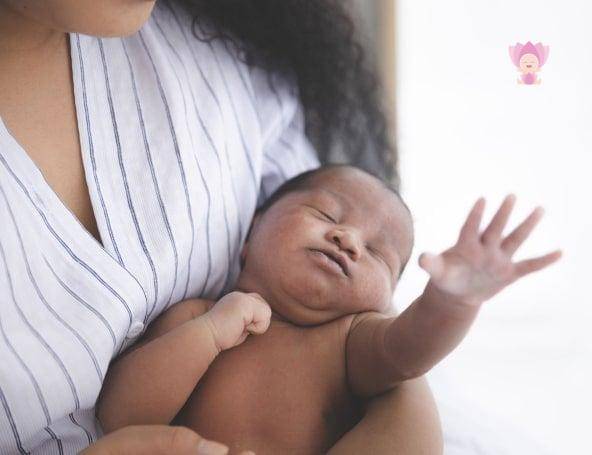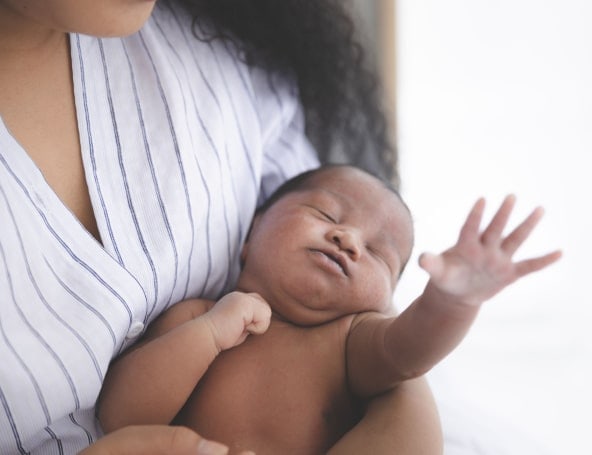Baby sleep stages: What is active sleep and quiet sleep?

Like adults, babies cycle through a series of different sleep stages at night, and understanding these stages can help us cope. Here’s a quick guide to some of the concepts, and how baby sleep stages develop over time.

What is a sleep stage, and how do baby sleep stages differ from adult sleep stages?
Years ago, researchers realized they could track brain activity – easily and painlessly – by attaching electrodes to a person’s face and scalp. And this led to the discovery of several distinct stages of sleep – each characterized to distinctive brain wave patterns, as captured on an EEG recording. You’ve probably heard about at least one of those sleep stages – REM, or “rapid-eye movement” sleep. But there are also several “non-REM” stages of sleep. In a healthy adult, sleep stages unfold in this sequence:
- NREM1 – a drowsy stage of light sleep; you may be semi-aware
- NREM2 – another stage of light sleep with some moments of deeper sleep
- REM
- NREM3 – “deep” sleep, characterized by slow brain waves
Once we’ve reached the end of this sequence, we say that we have completed a single sleep cycle. We either awaken, or repeat the cycle again. Adult sleep cycles typically last between 90-110 minutes. Over the course of the night, we may complete 4-6 cycles in total (Patel et al 2022).
What about babies? They, too, experience sleep in stages, and they repeat sleep cycles multiple times throughout the night. But for babies under the age of 3 months, things look quite different. Young infants begin the sleep cycle with something called “active sleep,” and then transition to another stage called “quiet sleep.” Let’s take a closer look.
What is active sleep?
“Active sleep” in babies is an immature form of REM. It is similar to REM sleep in adults, with its characteristic, back-and-forth movement of the eyes under the lids; high levels of brain activity; irregular breathing; and an elevated, but variable, heart rate.
Yet there is a key difference between infant and adult REM. Except for the eye movements and an occasional twitch, the adult body scarcely moves during REM. In fact, we experience muscle atonia (also known as “sleep paralysis”). By contrast, infant REM — active sleep — looks very restless. Young babies experience frequent twitches. They wriggle and thrash around. They flash facial expressions, make rapid sucking motions with their mouths, and they may even cry, grunt, or whimper (Barbeau and Weiss 2017; Dereymaeker et al 2017). And this can mislead parents into thinking that babies are awake and signaling for attention.
What is quiet sleep?
“Quiet sleep” is a form of non-REM sleep that young babies (0-3 months) experience. As you might suspect from the name, babies in quiet sleep appear calmer. There are no rapid eye movements, and their breathing and heart rates become more regular. In addition, babies move around much less – though you still might notice the occasional twitch. Overall, babies in quiet sleep are much less likely to make noise. They are sleeping more soundly.
Between 2 and 6 months postpartum, quiet sleep develops into the stages of non-REM sleep that we see in adults (Ficca et al 2000; Grigg-Damberger et al 2007; Grigg-Damberger 2017). These include NREM1 and NREM2 (light stages that appear by 2-3 months), and NREM3 (usually present by 4-5 months).
Is active sleep “light” sleep?
When we talk about someone sleeping lightly, we usually mean that the person can be easily awakened, or that they experience many, spontaneous arousals (where the brain emerges from sleep, at least briefly). And from that standpoint, a young baby in active sleep is definitely sleeping lightly.
For example, in one study, researchers monitored the naps of 10, healthy, normal babies between the ages of 2 and 10 weeks. When these babies were in active sleep, they experienced spontaneous arousals at an average rate of 32 per hour – more than one arousal every two minutes! By contrast, during quiet sleep, the frequency of arousals dropped by 50%. In addition, the researchers tried to deliberately awaken babies by touching them, and they found that babies were almost twice as likely to awaken when they were in active sleep (McNamara et al 2002).
How do baby sleep stages unfold during the night?
As noted above, the usual pattern for young babies to begin a sleep session in active sleep, and then transition to quiet sleep. Finally, babies shift back into active sleep, which completes a single sleep cycle.
Along the way, it’s common for babies to experience many, fleeting moments of waking. And they may wake up for as long as a minute or two after they complete that second bout of active sleep. In addition, young babies frequently experience hard-to-categorize sleep states – brief bouts of sleep that combine characteristics of active sleep (like vocalizations) and quiet sleep (like regular breathing). Researchers call this hard-to-categorize sleep “indeterminate” or “transitional”, and it typically occurs between the major sleep stages, and immediately before and after waking.
Thus — taking all these factors into account — a more detailed summary of a young baby’s sleep cycle might look like this:
- Active Sleep
- Indeterminate Sleep
- Quiet Sleep
- Indeterminate Sleep
- Active Sleep
- Brief waking (1-2 minutes)
- Indeterminate Sleep
But keep in mind: Baby sleep cycles develop and change over time!
By 2-3 months, many infants are beginning their sleep bouts in something other than active sleep, such as NREM1, or an indeterminate, transitional sleep stage (Grigg-Damberger 2016). Between 4-6 months, most babies will have developed all of stages of adult sleep, including the “deep” stage, NREM3 (Grigg-Damberger et al 2007).
How can you tell if a baby is awake or in active sleep?
As you might imagine, it can be tricky. In fact, experts have had trouble determining the moment when a young baby falls asleep – even when the infant is hooked up to electrodes that measure brain activity and muscle movement. A baby’s brain is so busy during REM, it can look very similar to that of a waking brain. And of course the baby may be twitching or making noise.
So researchers typically rely on the eyes to distinguish between active sleep and waking (e.g., Grigg-Damberger 2016). If the eyes are wide open for 20-30 seconds, they assume the baby is awake. Is this a good rule of thumb for parents to follow? Maybe…if you are able to look at your baby’s face without being disruptive. But what if your baby is in a dark room at night, and you can’t see his or her eyes without turning on the light?
If you’re in this situation, and your goal is to encourage your baby to sleep, a more practical approach is to listen for signs that your baby is actively signaling you, and wait longer than 30 seconds before you intervene. Because even if your baby has awakened, there’s a reasonable chance that he or she will fall back to sleep spontaneously…as long as everything is calm, quiet, and boring.
How much time do babies spend in active sleep?
It varies, but, on average, newborn sleep cycles range between 50-60 minutes in length, with about 25 minutes spent in active sleep, 20 minutes in quiet sleep, and 10 minutes in transitional or indeterminate sleep (Grigg-Damberger 2017).
As you can see, the single, biggest portion of sleep time (approximately 50%) is spent in active sleep, and this is perhaps the most distinctive characteristic of sleep in young babies. As children mature, they allocate less and less time to REM sleep. Around 12 months postpartum, most babies are spending only 30% of their total sleep time in REM. The percentage eventually drops to adult levels (20-25%) when kids are approximately 5 years old (Grigg-Damberger 2017).
Why is active sleep so prominent during early life?
That’s an interesting question, especially if you consider that it isn’t only human babies who seem to love REM. Across many different mammal species, there’s a pattern for infants to spend a lot of time in REM (Frank 2020), and researchers have confirmed that REM plays a critical role in brain development (Chen et al 2022). For example, it’s likely that the frequent twitches associated with active sleep are helping the brain develop the sensorimotor system – testing out how movements and sensations map onto brain circuits (Roffwarg et al 1966; Frank 2020).
In addition, it’s worth noting that the “light” nature of active sleep may have a protective effect, especially for young infants who encounter oxygen restriction. I mentioned earlier than babies in active sleep are more likely to awaken in response to being touched. The same is true when babies are subjected to low-oxygen environments. In experiments, babies challenged by a sudden reduction of oxygen were slower to awaken if they were in quiet sleep (Parslow et al 2003; Damberger et al 2007).
So while it can be frustrating to take care of a baby who awakens so easily, we can be reassured that active sleep has important (perhaps even crucial) benefits. And our babies will eventually develop more mature sleep stages, allowing for less disruptive nights. By 4 to 6 months, most parents will have noticed major improvements.
More reading
For more information about coping with newborn sleep, see my article, “Newborn sleep patterns: A survival guide.” And for help with older babies, see this Parenting Science article.
References: What is active sleep and quiet sleep?
Barbeau DY and Weiss MD. 2017. Sleep Disturbances in Newborns. Children (Basel). 4(10):90.
Chen HL, Gao JX, Chen YN, Xie JF, Xie YP, Spruyt K, Lin JS, Shao YF, Hou YP. 2022. Rapid Eye Movement Sleep during Early Life: A Comprehensive Narrative Review. Int J Environ Res Public Health. 19(20):13101.
Corsi-Cabrera M, Cubero-Rego L, Ricardo-Garcell J, Harmony T. 2020. Week-by-week changes in sleep EEG in healthy full-term newborns. Sleep. 43(4):zsz261.
Dereymaeker A, Pillay K, Vervisch J, De Vos M, Van Huffel S, Jansen K, Naulaers G. 2017. Review of sleep-EEG in preterm and term neonates. Early Hum Dev. 113:87-103.
Ficca G, Fagioli I, Salzarulo P. 2000. Sleep organization in the first year of life: developmental trends in the quiet sleep-paradoxical sleep cycle. J Sleep Res. 9(1):1-4.
Frank MG. 2020. The Ontogenesis of Mammalian Sleep: Form and Function. Curr Sleep Med Rep. 6(4):267-279.
Grigg-Damberger, MM. 2017. Ontogeny of sleep and its functions in infancy, childhood, and adolescence. In S. Nevšímalová & O. Bruni (Eds.), Sleep disorders in children (pp. 3–29). Springer International Publishing.
Grigg-Damberger MM. 2016. The Visual Scoring of Sleep in Infants 0 to 2 Months of Age. J Clin Sleep Med. 12(3):429-45.
Grigg-Damberger M, Gozal D, Marcus CL, Quan SF, Rosen CL, Chervin RD, Wise M, Picchietti DL, Sheldon SH, Iber C. 2007. The visual scoring of sleep and arousal in infants and children. J Clin Sleep Med. 3(2):201-40.
McNamara F, Lijowska AS, Thach BT. 2002. Spontaneous arousal activity in infants during NREM and REM sleep. J Physiol. 538(Pt 1):263-9.
Parslow PM, Harding R, Cranage SM, Adamson TM, and Horne RS. 2003. Arousal responses to somatosensory and mild hypoxic stimuli are depressed during quiet sleep in healthy term infants. Sleep 26(6):739-44.
Patel AK, Reddy V, Shumway KR, et al. Physiology, Sleep Stages. [Updated 2022 Sep 7]. In: StatPearls [Internet]. Treasure Island (FL): StatPearls Publishing; 2022 Jan-. Available from: https://www.ncbi.nlm.nih.gov/books/NBK526132/
Roffwarg HP, Muzio JN, Dement WC. 1966. Ontogenetic development of the human sleep-dream cycle. Science 152(3722):604-19.
Wielek T, Del Giudice R, Lang A, Wislowska M, Ott P, Schabus M. 2019. On the development of sleep states in the first weeks of life. PLoS One. 2019 Oct 29;14(10):e0224521.
Content last modified 11/2022
image of sleeping baby reaching with arm by Perfect Angle Images / shutterstock. The version here has been cropped.















